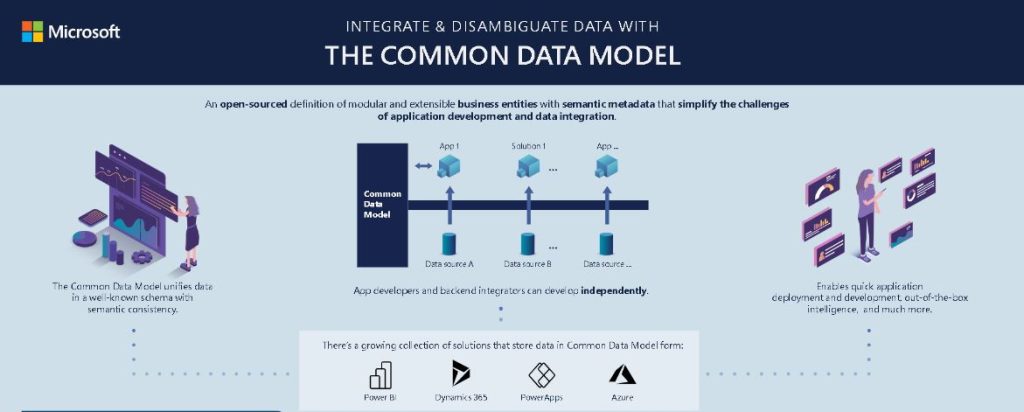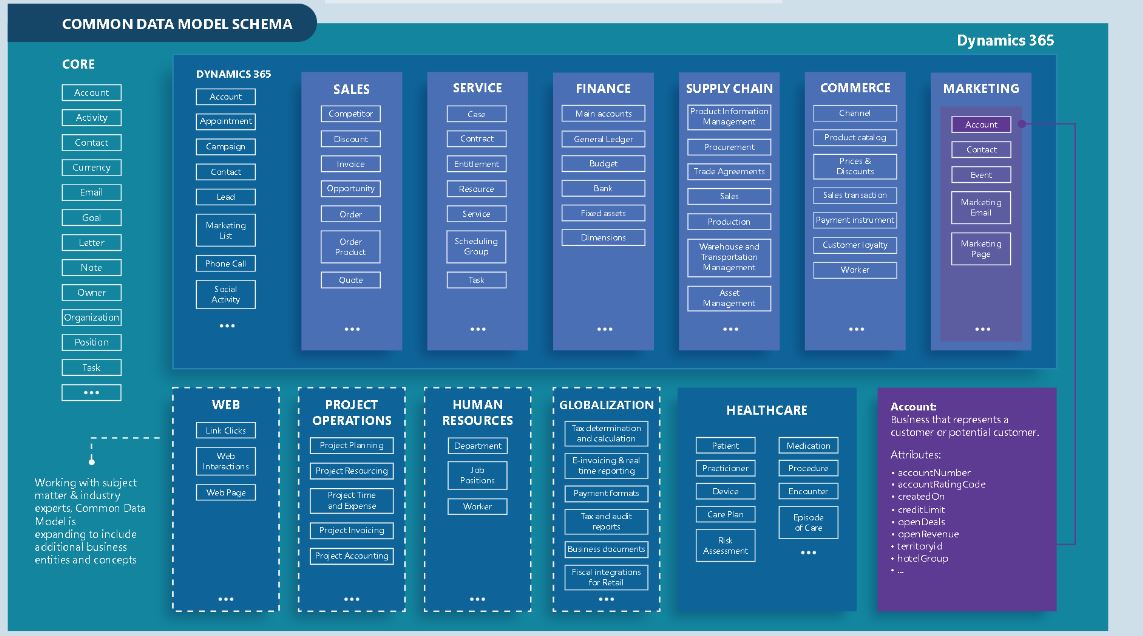No doubt, data is critical to building business applications. Companies traditionally build silos of information and data that only multiply once the applications increase. In return, you have no unified view across applications and cannot build workflows that work across processes and functions seamlessly.
Fortunately, Microsoft 365 launched the common data model (CMD), a more evolved database that enables users to build and manage applications faster. With CMD, Microsoft empowers businesses to boost their operational efficiency with a unified business data view. As a result, they can determine the right actions while empowering their employees to maximize the results. Plus, they can achieve a new level of effectiveness, agility, and efficiency to lead to sustainable competitive advantage.
If you are new to Dynamics 365 common data model or want to learn more about it, keep reading!
What is Dynamics 365 Common Data Model?
Dynamics 365 common data model is designed to simplify the data integration and management across business processes and applications. Microsoft introduced CDM as an integral part PowerApps offering. PowerApps Consulting service provides a custom business application.
Launched in April 2016, CDM is considered an “out of the box” database that stores and manages business entities. It is built for scale and encrypted at rest, where the system utilizes the best Azure technologies like elastic SQL and Service Fabric.
Besides providing standard business entities, CDM enables you to build custom entities by creating a new entity or extending the standard entity. With CDM, you can take advantage of well-structured metadata, business data types, lookups, auto numbering, rich data types, and cascade deletes. In other words, it creates a gripping functionality.

How Does Dynamics 365 Common Data Model Work?
As you know, an app-by-app basis through custom builds is necessary to create a two-way communication channel between apps. However, this makes the integration difficult to maintain over time, expensive, and challenging.
The good news is that Dynamics 365 CDM enables apps to easily integrate and share data even without custom and extensive integration. That is possible because of the centralized point where systems connect and bridge the gap between the information repositories after being divided by the digital language barrier.
While each application has a different structuring, labeling, and recording data, CDM comes with regulated entities that disambiguate data from various sources by mapping it to the unified entities from its library. Once you use the key-type entities, expect all apps can communicate, understand, and recognize the information found on the CDM’s “data lake.”
For instance, Dynamics 365 for Finance and Operations and Dynamics 365 are designed to store and process data. However, these two are not identical. They support the use of multiple international currencies. However, the method to record the currency data on every transaction is not the same in the two applications. Using CDM, the two applications are allowed to match up the currency data in a regimented manner.
Whether you are working within custom applications or Dynamics 365 landscape, CDM offers an excellent way to manage data between apps with overlapping entities. For instance, CDM ensures that any change in an ERP application is seamlessly reflected in other apps.

What Can You Expect from Dynamics 365 Common Data Model?
The MS common data model represents a reliable and secure business database compromising well-structured entities deployed in an organization. It aims to enhance your business operational efficiency by offering universally agreed business data. After all, data is the most critical wealth of every organization.
As CDM helps your organization with unified data viewing to empower your employers, you can help them maximize their output while driving a competitive organizational growth. With the CDM, your business can connect the official data from apps with the information held in Office 365.
Since MS has introduced a common data model as the glue that links and keeps all business entities together on a single integrated system, all components collectively work across the ordinary product lines.
CDM ensures that you can create an app for Android, iOS, and Windows by using the PowerApps over time. Then, you can build a common connection to Software as a Service (SaaS) services, including Excel, Dropbox, MS Office 365, and Twitter. It introduces you to the most straightforward process to build applications that do not involve coding.
What are the Entities in the Common Data Model?
One of the interesting things about CDM is that it offers some of the most standard business entities in major industrial domains, such as customer services, productivity, purchase, and sales. Plus, these entities are well connected with the first-party business apps of Microsoft. They reasonably support ISV’s broadest ecosystem and customer solution development.
Here are the features used to build entities in CDM:
- Rich Data Types. These include business abstractions such as auto-numbering, currency, email, address, modern types like phone, web URL, geolocation, images, application on enterprise data, etc.
- Structured Metadata. The entities in CDM are well-structured with data definition, defaulting, and behavior modeling.
- System Attributes. Each entity in CDM comes with attributes for ModifiedByTime, ModifiedByUser, CreatedByDateTime, CreatedByUser, DataPartition, RecordId, and RecordVersion. Then, CDM utilizes these system attributes to deliver functionalities for several issues like audit management, concurrency management, data manipulation, isolate division, or data sharing amidst enterprise.
- Data Constructs. These offer support for containment, aggregates, lookups, modeling relationships, etc.
- Declarative Referential Integrity. This practice ensures that users have nothing to worry about data left isolated in the system.
- Database Normalization Patterns. They support the entities’ maximum performance and simplicity.
- Field Level Security. Every entity in CDM is configured with field-level security.
- Simple Mapping. The system supports Microsoft business applications’ simple mapping that makes unique field data and data validation provides default value support, and ensures data encryption at rest.
Common Data Model in Multiple Platforms and Applications
Your business can utilize the common data model in multiple platforms and applications, including:
Dataverse (Common Data Service )
You can utilize dataverse (common data services) to store data together in CDM’s standardized format and create robust applications.
Industries
Industries such as non-for-profit, higher education, and healthcare work closely with Microsoft to ensure that CDM becomes more relevant to them via Industry Accelerators. The standard entities of CDM extend the advantages to these verticals to ensure that industry solutions will operate together seamlessly and effortlessly.
Power BI Dataflows
Power BI DataFlows: You can load data into the CDM from different sources, including SharePoint, Azure SQL Database, or MS Dynamics 365. After connecting and preparing data, you can start building report-generating applications that can pull data from the CDM insights for the stakeholders automatically

What are the Key Benefits of the Common Data Model?
If it is your first to hear about CDM, you may wonder why you should use it.
Imagine that you have three business applications, one each for sales, manufacturing, and materials. Each application is likely created independently, with varying structures representing an entity. If you utilize CDM, you have a chance to build data in a standardized format, where each application can utilize the same data.
Each application may have additional schemas and data, depending on the functionality. However, the reports and application can pull data elements cleanly and quickly with regard to development.
In the case you require to create a fourth application, the data is ready in the CDM schema. This means you can focus your development efforts on business logic instead of sticky transformations and data quagmires.
Here are other advantages of the common data model:
Use Many Applications
The data found CDM can be utilized in many applications. This streamlines the report creation for every or all of those applications.
Simplified Integration Process
Another advantage of using CDM is that it simplifies the integration process. It is made possible by delivering integration of templates between two systems. If you use MS Dynamics 365, customer data integration from Dynamics 365 for Sales is very straightforward. Plus, it also enables easy financial information integration from Dynamics 365 for Finance and Operations.
Uniform Data Management Templates
Common data model delivers uniform data management templates, which help simplify business processes. Interestingly, these templates are designed to guide administrators throughout the process effortlessly and quickly.
Extend the Schema and Standard Entities
CDM will help you extend the schema as well as standard entities. That way, your application can leverage the platform’s full power easily.
Deeper Analytical Services Access
As a Dynamics 365 user, you can employ tools from the Power BI suite so that you can monitor your business health while getting the insights necessary for making a better decision. With CDM, you can access deeper analytical services that provide you with a data lake directly integrated into the Power BI. This means you can get a complete business overview quickly by utilizing data pulled from multiple sources.
Conclusion The common data model is critical to different industry functions and verticals. It runs in the cloud and customizable. So, it brings the advantage of apps that access data that you can run on mobiles and desktops. Plus, the Dynamics 365 CDM enables your organization to connect data from apps with information from the productivity platform










